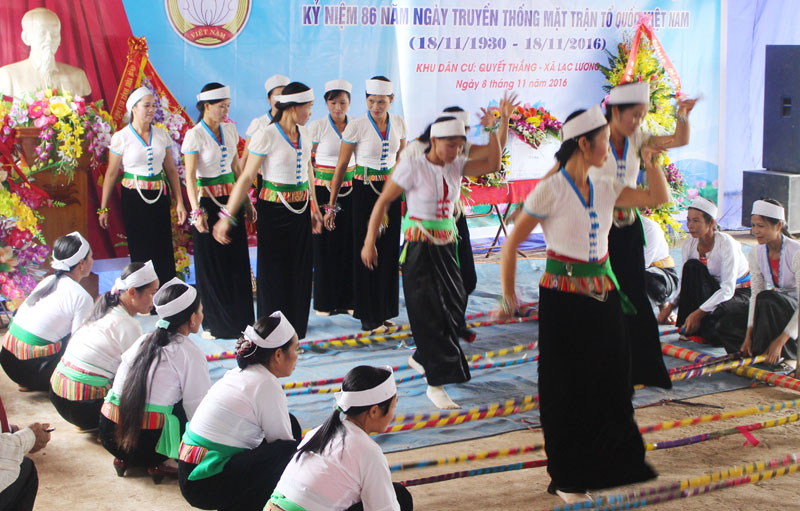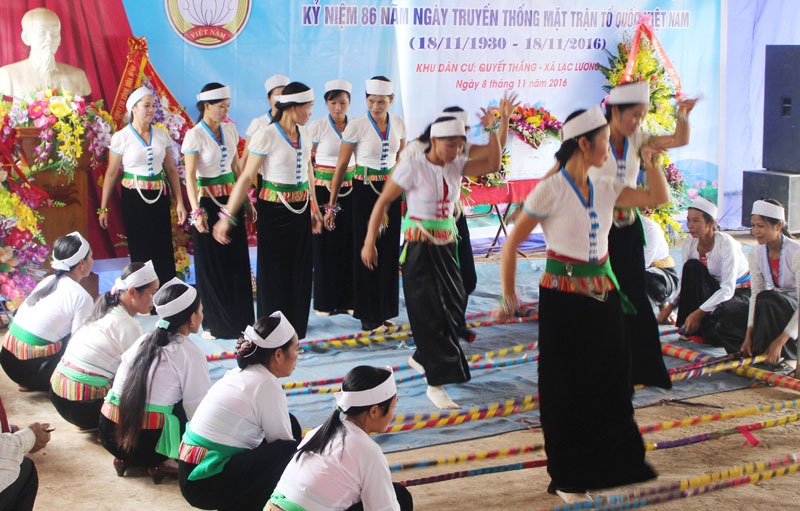



Bamboo Dance becoming a form of cultural
exchange, linking ethnic communities. Photo taken at Quyet Thang hamlet, Lac
Luong commune (Yen Thuy).
Bamboo dance came to the people who grow up
in Hoa Binh very naturally. Over the years, the styles of bamboo dance have
been ingrained in the people’s minds. There are some cultural values that exist
in such a special way like that so it is easy to understand why bamboo dancing
is the typical and popular dance of Muong ethnic group.
The instruments needed for bamboo dancing are
two big trees, usually made of bambusa nutans, straight and long, which make up
the main stalls and many pairs of bamboo stalls with 3-4cm in diameter and 3-4m
in length. The local people use those to create tools for making sounds and
dance rhythm. In addition, everyday items such as bows, brocade towels, silk
towels are also put into the dance. Men are dancing with bows; ladies are
dancing with fans, silk scarves. Depending on each place, each cultivation and
living habits that people choose the suitable tools to dance with.
The concept of balance, harmony of bamboo
dance also follows certain rules. The dance team consists of a flapping group
and a dancing group. Each group can be from several couples to many couples,
the more couples there are, the richer and livelier the team is. However, the
number of men and women is always equal. The movement of the men should be
healthy to show the brave, the women are flexible, gentle and even movements of
the hands and legs shaking. The bamboo dance requires the dancers to feel the
music, hands and legs must be together into a unified point.
Bamboo dance of Muong ethnic people
originated from a simple folk game that has now become the art of dance. The
start was the game of pestle beating and stick beating. Throughout the
development process, the art of bamboo dance has become much richer, livelier
with high artistic content.
Mr. Bui Van Khan, a bamboo dancing artist in
Ai village (Phong Phu commune, Tan Lac district) said: According to the
migration process, Muong ethnic people live closer to other ethnic groups,
bamboo dancing has become a form of cultural exchange. The dance is simple,
easy to learn but exciting, has made a bridge among the peoples of the ethnic
groups.
Under the stilt house, beside the stream, the
sounds of the bamboo dance still ring when friends far away can find. The dance
has gone through many ups and downs with many changes are now bustling in
laughter, cheerful echo, will remain forever with the village, with mountains
and forests of the northwest area.
At the end of May, the Hoa Binh Provincial Ethnic Arts Troupe organized a series of performances for residents in Region 2 and Region 3 communes across the province. Bringing art to ethnic communities in remote, isolated, and especially disadvantaged areas has become a meaningful activity. These are not merely artistic performances but also journeys to disseminate cultural values, enrich spiritual life, and contribute to preserving the cultural identity of ethnic minorities.